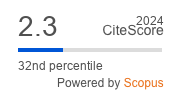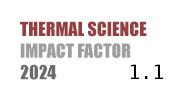THERMAL SCIENCE
International Scientific Journal
MATHEMATICAL AND NUMERICAL INVESTIGATIONS OF FRACTIONAL STOCHASTIC EPIDEMIC MODEL
ABSTRACT
Sexually transmitted diseases are infectious diseases and a significant threat to human health. In this work, a standard integer-order model of Chlamydia is transformed into a fractional-order stochastic mathematical model. The steady-state of the continuous system is determined and considered for disease forecasting and stability analysis. The fractional stochastic system is tested for stability at both equilibrium states by following the classical Jacobian matrix theory. It is investigated the underlying epidemic model has a unique solution. The non-negative and bounded solutions of the model also provide a deeper understanding of the disease propagation. Then, a finite difference numerical algorithm is constructed for approximating the solution. To assess the efficiency of the algorithm, non-negativity and boundedness of the numerical method are investigated. Furthermore, the algorithm is applied to a test example to obtain the simulated graphs. Ultimately, the study's outcomes are summarized in the form of conclusions.
KEYWORDS
PAPER SUBMITTED: 2024-12-02
PAPER REVISED: 2025-02-10
PAPER ACCEPTED: 2025-04-30
PUBLISHED ONLINE: 2025-09-26
THERMAL SCIENCE YEAR
2025, VOLUME
29, ISSUE
Issue 5, PAGES [3669 - 3679]
- Ahmed, S. M., et al., A Systematic Review and Meta-Analysis of the Global Seasonality of Norovirus, Plos One, 8 (2013), 75922
- Marshall, J. A., Bruggink, L. D., The Dynamics of Norovirus Outbreak Epidemics: Recent Insights, Int. J. Environ. Res. Public Health, 8 (2011), 4, pp. 1141-1149
- Rohayem, J., Norovirus Seasonality and the Potential Impact of Climate Change, Clin. Microbiol. Infect., 18 (2009), 6, pp. 524-527
- Carmona-Vicente, N., et al., Norovirus Infections and Seroprevalence of Genotype GII.4-Specific Antibodies in a Spanish Population, J. Med. Virol., 87 (2015), 4, pp. 675-682
- Anwarud, D., Li, Y., Stochastic Optimal Control for Norovirus Transmission Dynamics by Contaminated Food and Water, Chin. Phys. B, 31 (2021), 020202
- Hossein, J., Daftardar-Gejji, V., Solving Linear and Non-Linear Fractional Diffusion and Wave Equations by Adomian Decomposition, Appl. Math. Comput., 180 (2006), 2, pp. 488-497
- Li, X.-P., et al., A Dynamical Study of SARS-CoV-2: A Study of the Third Wave, Results Phys., 29 (2021), 104705
- Razia, B., et al., A Fractional Order Zika Virus Model with Mittag-Leffler Kernel, Chaos Solitons Fractals, 146 (2021), 110898
- Osman, T., Tunc, C., Ulam Stabilities of Non-Linear Iterative Integro-Differential Equations, Rev.. Real Acad. Cienc. Exactas Físicas Nat. Ser. Matemáticas, 117 (2023), 118
- Muhammad, Shoaib, A., et al., A Reliable Numerical Analysis for Stochastic Hepatitis B Virus Epidemic Model with the Migration Effect, Iran. J. Sci. Technol. Trans. A Sci., 43 (2019), June, pp. 2477-2492
- Lu, Q., Stability of SIRS System with Random Perturbations, Phys. A Stat. Mech. Its Appl., 388 (2009), 18, pp. 3677-3686
- Liu, P., et al., Numerical Dynamics and Fractional Modeling of Hepatitis B Virus Model with Non-Singular and Non-Local Kernels, Results Phys., 39 (2022), 105757
- Zhang, X.-B., et al., Extinction and Stationary Distribution of a Stochastic SIRS Epidemic Model with Standard Incidence Rate and Partial Immunity, Phys. A Stat. Mech. Its Appl., 531 (2019), 121548
- Raizah, Z., Zarin, R., Advancing COVID-19 Understanding: Simulating Omicron Variant Spread Using Fractional-Order Models and HaarWavelet Collocation, Mathematics, 11 (2023), 1925
- Simone, G., et al., MCD and Induced CD of a Tetraphenoxyperylene-Based Dye in Chiral Solvents: An Experimental and Computational Study, Symmetry, 14 (2023), 1108
- Zarin, R., et al., A Numerical Study Based on Haar Wavelet Collocation Methods of Fractional-Order Antidotal Computer Virus Model, Symmetry, 15 (2023), 621
- Ting, C., et al., Fractal-Fractal and Stochastic Analysis of Norovirus Transmission Epidemic Model with Vaccination Effects, Sci. Rep., 11 (2021), 24360
- Podlubny, I., Fractional Differential Equations. Mathematics in Science and Engineering, Academic Press, New York, USA, 1999
- Raezah, A. A., et al., Numerical Approach for Solving a Fractional-Order Norovirus Epidemic Model with Vaccination and Asymptomatic Carriers, Symmetry, 15 (2023), 1208
- Shah, N. H., et al., Mathematical Model for Transmission of Chlamydia due to Sexual Activity and an Unhygienic Environment, Explor Med., 3 (2022), Apr., pp. 375-385
- Hossein, J., et al., Application of the Laplace Decomposition Method for Solving Linear and Non-Linear Fractional Diffusion-Wave Equations, Appl. Math. Lett., 24 (2011), 11, pp. 1799-1805
- Herzog, F., Stochastic Differential Equations, Lecture Notes, 2013

